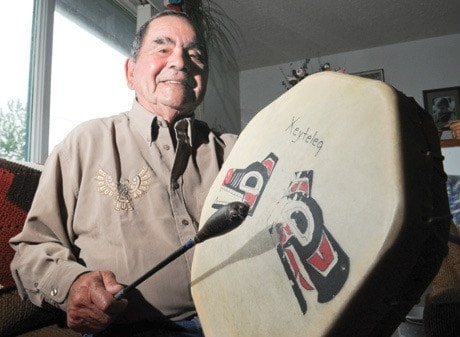In today’s world, Coqualeetza elder Ray Silver and his people of the Sto:lo nation are free to speak their native language.
It was not always that way. Growing up in the 1930s, the Halq’emeylem tongue was forbidden by the government, even punishable by imprisonment, so his fearful parents didn’t teach him.
Since practising their culture was illegal, many traditions, such as powwows or gatherings, were stopped.
“Right here in Sumas we had a great big longhouse where people from all over came,” recalls Ray, now 82.
“And the elders spoke to the younger people about who they were and what they were to do. To look after Mother Earth, respect one another, learn who we were.”
Now an elder himself, Ray said when he was a child his elders told him stories about the sacred caves on Sumas Mountain that brought winter songs to his people.
“It was a gift from the Great Spirit for our people.”
Ray will be among an expected 5,000 people attending the upcoming annual Elder’s Gathering at the Abbotsford Tradex on July 12-14.
The gathering has been held every July in B.C. since the first one in Mission in 1977. Ray’s wife, Millie, is co-chair of the event and was an integral part of winning the bid to have the gathering return to the Abbotsford area.
“What we’re doing with our gatherings is we’re bringing our voice back, and we’re bringing it back to our young people,” said Millie, adding that opening the gathering to everybody helps that cause.
Ray said it isn’t just young people in his community who are interested in learning more about history, and he credits Abbotsford for opening up to him and his people.
“The places that we go and the schools where we speak ... they’re really interested in the native culture and how the people lived a long, long time ago.”
Born in 1929, Ray grew up in Abbotsford during the Great Depression, when prejudice was more plentiful than money.
It was 1940 when he and his younger brother, Dalton, started public school in Sumas. When the department of Indian Affairs found out, they placed them both in Presbyterian Coqualeetza residential school without the permission of his parents.
After Coqualeetza closed that year, they were shipped out to Port Alberni residential school on Vancouver Island.
But Ray said he didn’t learn to read or write there and conditions were squalid.
Eventually, he was told he would be returned to the mainland with two of his first cousins. But his happiness was mixed with terrible grief.
“Coming home, I asked the principal, ‘Where’s my brother, isn’t he coming with us?’ He says, ‘Yeah, your brother’s coming.’ And when the ferry blew its whistle at the CPR dock in Vancouver, he says, ‘Your brother’s downstairs, in a box.’ He died.”
Ray buried Dalton on Sumas Mountain, and afterwards told his parents he’d never go back to school again. And he never did.
His father worked at the local Clayburn brick-making plant with 180 other native and white workers. When Ray turned 15 he also got a job at the plant, working for 54 cents an hour until it burned down in 1948.
“That was big money,” he says, smiling.
Since there weren’t many native kids his age, he would go fishing in Marshall Creek with the white children of the brick workers. They caught trout and salmon in the spring, as millions of fish would come down the rivers, which he said kept many families fed during the Depression.
“We had hazelnut poles and linen thread for our lines and a homemade hook to catch the trout. And the water was so clean you could see them go after the worm.”
The Sto:lo are river people, Ray says, and he used to paddle the Sumas to the Fraser with his grandfather.
When he was a boy, his grandfather told him the river provided everything his people needed: water for tea, salmon, sturgeon and nourishment.
“You look after that water, respect that water, and it’ll respect you forever. That was the teaching I got from my grandfather, probably close to 80 years ago.”
His grandfather told him the rivers are “blood vessels across the body of Mother Earth,” and to protect the rivers as he would his own body.
Much has changed in the years since Ray was a child listening to his elders.
Now he’s invited by community organizations, hospitals and schools to speak about his culture and people.
Ray says the voice of his people, once lost, has been restored.
Elders Gathering at Tradex
The 35th annual BC Elders Gathering takes place at Tradex July 12-14.
It is returning to the tribal grounds of the Sto:lo Nation, in Abbotsford, 35 years after the first meeting.
The gathering is held in different parts of B.C. each year.
This year, for the first time, it will be open to anyone, not just elders. That means organizers are expecting up to 5,000 visitors.
The Elders Gathering is a way of preserving common heritage and traditions of First Nations.
The gathering will feature workshops on financial management, elder abuse, and scheduled tours of the Sto:lo territory. There will also be traditional games, dances and songs at the Sumas Longhouse.
Registration begins at 8 a.m. and costs $50.
